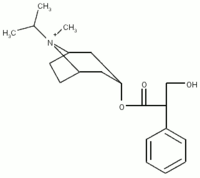Asthma management includes treatment of airflow obstruction and airway hyperresponsiveness to varied stimuli. Treatment of acute exacerbations involves the use of bronchodilating agents to resolve bronchospasm. Beta2 agonists have been shown to be effective and are recommended as first-line treatment for these acute episodes. The role of anticholinergic bronchodilators, including ipratropium, however, in the management of acute exacerbations is less clear. Stoodley and associates conducted a meta-analysis of all clinical trials in which ipratropium was used as an adjunct to beta2 agonists in the treatment of acute asthma exacerbation in adults. The purpose of this analysis was to determine whether the addition of the anticholinergic agent provided additional benefit.
A MEDLINE search was conducted using the following inclusion criteria: a target population of adults with acute exacerbations of asthma; use of ipratropium as adjuvant therapy to beta2 agonists; and a randomized, placebo-controlled study design. A total of 10 studies that reported peak expiratory flow (PEF) rate, forced expiratory volume in one second (FEV1), or both, met the study criteria. The effect of ipratropium compared with placebo demonstrated a pooled improvement in FEV1 of 7.3 percent and an improvement in PEF rate of 22.1 percent. Studies that evaluated hospitalization rates revealed that patients receiving ipratropium had a relative risk of hospitalization of 0.73. None of the trials reported any serious adverse effects attributable to single- agent or combination treatment.
Combination therapy appeared to have greater absolute positive effects in patients with more severe outflow obstruction at baseline. The effect of combination therapy was not related to mean patient age or to the type of beta2 agonists used. All studies used 0.5 mg of ipratropium administered by nebulizer; therefore, the dose-response relationship could not be studied.
The authors conclude that even though ipratropium confers a benefit over that obtained with a beta2 agonist alone in treating acute asthma exacerbations in adults, the clinical significance of this improvement is uncertain. More data about patients, such as symptoms, gas exchange and length of stay in the emergency department, are required to ascertain clinical significance. Hospitalization rates were available in only three of the 10 studies. Even though the data are inconclusive, the use of combination therapy seems reasonable in treating acute exacerbations in the emergency department. Note that these studies evaluated nebulized preparations, and the current trend in emergency departments is to use metered-dose inhaler preparations because of the lower cost. Therefore, additional studies are needed to evaluate the cost-effectiveness of these preparations.
Stoodley RG, et al. The role of ipratropium bromide in the emergency management of acute asthma exacerbation: a meta-analysis of randomized clinical trials. Ann Emerg Med July 1999;34:8-18.
editor's note: The addition of nebulized ipratropium in the emergency department to the usual regimen of corticosteroids and albuterol also has been shown to reduce hospitalization rates in children. Some studies have demonstrated even shorter durations of treatment in the emergency department and fewer albuterol doses needed. Evidence for adding ipratropium to the treatment regimen for acute asthma exacerbations in patients of all ages is mounting. However, the value of ipratropium in the admission rates of patients with less severe asthma symptoms is not as clear.-r.s.
COPYRIGHT 2000 American Academy of Family Physicians
COPYRIGHT 2000 Gale Group



